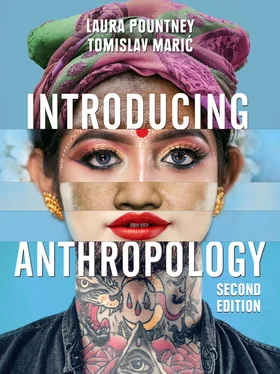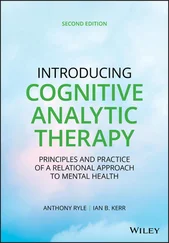For each evaluation above, link the strengths and weaknesses to the anthropological case studies that you know. You can use the examples of the studies from this and other chapters.
What is participant observation?
Is it ever possible for anthropologists to be accepted by the people they study?
What are the practical issues that need to be considered when living with a community?
What reduces the cultural barriers between the fieldworker and the people being studied?
Who is a gatekeeper?
What are the ethical issues that fieldworkers need to consider?
What is ethnography?
Although the main method of ethnography is participant observation, the fieldworker has to conduct interviews as well. This can take the form of one-to-one in-depth interviews, group interviews or simply general talking and asking questions. It is difficult to describe how to conduct an interview since it will depend on the skills of the fieldworker, but ideally it needs to resemble everyday conversation, which is informal and free flowing. Researchers are unlikely to have a set of questions, although there are likely to be certain topics they wish to cover. An unstructured interview offers greater opportunity for respondents to take control of the situation, providing them with the scope to express their own views. This will increase the validity of the data obtained, since there is a greater chance that the views expressed by the interviewee will present a true, accurate description of what is being studied. The researcher is also able to probe with further questions or to ask the interviewee to expand or clarify a point that has been made. This, again, provides more depth to the data. Despite these advantages, unstructured interviews have their limitations. For example, the researcher might ‘probe’ a little too far, directing the discussion and thereby steering the conversation away from what the interviewee wants to talk about. This influence is called interviewer bias. A similar problem occurs when the researcher is able freely to interpret what the interviewee is saying. Misleading and inaccurate interpretations will reduce the validity of the research. Generally, people like to present themselves in a favourable light. This can result in interviewees emphasizing socially desirable aspects of their behaviour and attitudes in the presence of the researcher. Consequently, interviewees might exaggerate or lie.
interviewer biasWhen an interviewer’s opinions or approach to questioning direct the discussion, steering the conversation away from what the interviewee wants to talk about

If you came upon this group of people, would you be able to figure out what was going on? What cultural patterns could you identify and understand? For instance, what is the significance of the colours and styles of clothing? Why are all the girls together? What are they waiting for? Where are they? Is the arrangement of people in this photo random? What questions would you ask them to find out what they are doing? (© Maria Salak)
| AdvantagesCan gain an in-depth understanding (especially via rapport) Interviewees can develop their answers and interviewers can probe deeper Can change direction of interview if new ideas emerge Can compare observation of the respondent with replies given (e.g., body language) Good for sensitive groups and/or topics |
DisadvantagesInterviewer bias Social desirability effect – people like to make themselves look good (may lie) Time-consuming and costly Difficult to compare interviews – each is unique Fewer interviews conducted affects representativeness and means it is more difficult to make generalizations |
STOP & THINK
What are open-ended questionnaires?
How do you conduct an interview?
What are the advantages and disadvantages of using questionnaires in anthropological research?
The life history, or personal narrative of one’s life, is an important research method in anthropology for learning about how culture is experienced and created by individuals. It involves collecting and recording individuals’ experiences, and can be done either by the individual writing down their own life story or by using semi-structured or unstructured interviewing, often tape-recorded, which the researcher then writes up.
Life histories are a rich source of insight both into a person’s individual experiences, presented from their own point of view, and into the wider social forces that affect their lives. For example, they can provide an insight into how war affects those who live through it. This approach, like other kinds of ethnography, places most importance on the person’s own interpretations and explanations of their experiences.
However, life histories obtained through interviews require the researcher to be able to empathize with the subject and to have good listening skills. Such interviews are also very time-consuming and labour-intensive. They rely upon the interviewee’s memory recall, which can sometimes be distorted, unclear or lacking altogether, and they are also unrepresentative of the population as a whole. So, even though they may give us an insight into one person’s experience, that might not be representative of other people’s experiences at that time.
Conduct a life history project in which you have to carry out an extended series of interviews with a chosen informant in order to ascertain what effects globalization has had on his or her life. Transcribe the interviews and write a report that includes themes such as childhood, education, career and family.
You should choose an older person who has experienced changes throughout his or her life.
Reflexivity in anthropology
In ethnography, reflexivityhas come to mean thinking carefully about who has undertaken the research, under what conditions, how it was written up and what impact these questions might have on the value of the ethnography produced. In anthropology, reflexivity has come to have two distinct meanings, one that refers to the researcher’s awareness of an analytic focus on his or her relationship to the field of study, and the other that attends to the ways that cultural practices involve consciousness and commentary on themselves. In the following case study, Mwenda Ntarangwi reflects on his experience of being an African anthropologist in American culture.
reflexivityThe process of reflection on the research process
An African ethnography of American anthropology (Mwenda Ntarangwi)
Anthropologists are not only good at studying other cultures and communities in depth, they also frequently turn their analytical eye on themselves and their practices. They look at how their gender, race, social class, ethnic identity and other identity markers shape their ethnographic studies and the analyses they undertake of the data collected. This analytical look on themselves is the approach I have taken in my book Reversed Gaze: An African Ethnography of American Anthropology (2010). I present a side of Western anthropology that is not commonly accessed by many who read anthropological literature, even including that which is found in accounts of field experiences that culminate in reflexive ethnographies and memoirs that have now become standard contributions. My focus is anthropologists’ identities as they ‘practice’ anthropology within academic departments, professional meetings, classrooms and lecture halls, and through ethnographic writing, all of which constitute the ‘other side’ of anthropological practice that is often absent in scholarly papers, ethnographies and memoirs. To do this, I ask a number of questions, including the following:
Читать дальше













